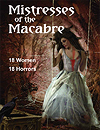 Genre: Introduction / Editorial
Genre: Introduction / Editorial
Year written: 2013
Year first published: 2013
Where You Can Find It
Mistresses of the Macabre, print anthology, by Dark Moon Books, 2013.
History
The anthology’s editor, Lori Michelle, wrote and asked me to write the introduction for her anthology of short horror stories by women authors. This coincided with the publication of DEEP CUTS, my own anthology that honored women horror writers, so I was already fired up on this topic. The best part of writing this introduction was reading the stories in the book. They’re a well-chosen array of horror tales, many of which stuck with me long after I’d read them.
Excerpt from the Introduction I Wrote
Women have written horror for longer than it’s been a recognized genre, and we’ve lived with horror for as long as we’ve walked the Earth. Let me explain.
The obvious connection that women have with blood—menses—curses us all. So often, men are surprised—and horrified—to discover exactly what goes on between our legs on a regular basis: the shedding of linings, the gushes of blood, and the pain through which we suffer time and again, as predictably as the rising of the moon. We hide it so well, most of the time.
This monthly blood-letting has long been a mystery that has inspired fear, prejudice, and superstition. It has helped to solidify the line between men and women, and it has been used as an excuse for keeping women out of “men’s business.”
Richard Webster, speaking about historical superstitions in the Encyclopedia of Superstitions (Llewellyn Publications, 2008), says, “People looked at a menstruating woman with horror and awe, because although she lost blood, she continued to live. Menstruating women had to remain out of sight, as it was thought that they brought potential danger to the whole tribe. Even making eye contact with a menstruating woman was considered dangerous.”
But not all the damage was done by men. In proceedings of the Royal Society of Medicine, 1915, Raymond Crawfurd wrote an article entitled “Of Superstitions concerning Menstruation.” In this article, he describes how British farmers’ wives believed that a “menstruous woman” could not be trusted with milk because once she had touched it, it could no longer be churned into butter. They clung to this belief, despite the evidence to the contrary.
Women have carried the mark of “uncleanliness” since before the Middle Ages. Judaism, Hinduism, and Islam have histories of labeling women as “unclean.” Leviticus 12 (Old Testament) warns that a woman who has just had a boy child remains “unclean” for seven days afterward (as she is during her customary impurity [menstrual cycle]). This state is contagious, thus explaining why boys aren’t circumcised until the eighth day. The boy child is infected with his mother’s impurity until then.










